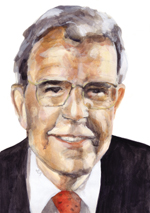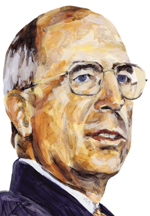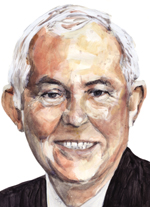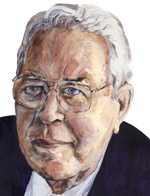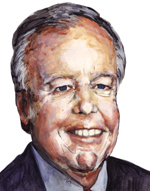Bannister joined DynCorp in 1953 and became president and chief executive officer of the company in 1985. In 1988, he led DynCorp's conversion from a company that was publicly traded to one that was privately held and employee-owned. The company continued to grow, reaching $2.3 billion in 2003, up from about $646 million in 1989. In 1997, he stepped down as CEO and became chairman. He held that post until the company was sold to Computer Sciences Corp. in March 2003 for $930 million.Bannister's consulting contract with CSC runs out at the end of this year. He also is chairman of Social and Scientific Systems Inc., a small employee-owned and woman-owned company. He serves on boards at Shenandoah University, George Mason University and Marymount University. He also is an adviser at NextGen Capital.XXXSPLITXXX-Founded Science Applications International Corp. in 1969. Served as CEO until retiring in November 2003. Beyster remained chairman until retiring from that position in July. During his 35 years leading the company, SAIC grew from a startup with a handful of employees in one office to a firm with 44,000 employees and $6.7 billion in annual revenue.Beyster will continue to be an evangelist for employee ownership through his Foundation for Enterprise Development and the Beyster Institute at the University of California in San Diego. He also has consulting contracts with British Petroleum and the U.S. Strategic Command. XXXSPLITXXX-From 1992 to 1997, Odeen was president and CEO of BDM International Inc. The company's annual revenue grew from about $300 million to $1 billion. He also led the company through an initial public offering and subsequent sale to TRW Inc. He ran TRW's information systems division, which generated $3 billion in annual revenue. He then served as chairman of TRW and sold the company to Northrop Grumman Corp. He has been chairman of the Defense Science Board, an industry group that advises the Defense Department.Odeen is the chairman of Apogen Technologies Inc., a $200 million-a-year systems integrator that was created through the merger of ITS Services Inc. and Science and Engineering Services Inc. He is active on the Defense Science Board and serves on the boards of Northrop Grumman, Avaya Inc., Convergys Corp. and the AES Corp. He also is acting CEO and chairman of Reynolds and Reynolds Co., an automotive services firm.XXXSPLITXXX-Rossotti was a cofounder in 1970 of American Management Systems Inc., one of the first IT services and consulting firms. He was CEO until 1993 and chairman until 1997, at which time the company had grown to about $1 billion in annual revenue. In 1997, he left the private sector to become commissioner of IRS. He kicked off the agency's massive business modernization effort, which is still ongoing. He stepped down from IRS in 2002.Since leaving IRS, Rossotti has been a senior adviser at the Carlyle Group, a global investment group. Rossotti also serves on the boards of AES Corp., an energy company; the investment firm Merrill Lynch; Liquid Engines Inc., a cash flow and tax management software company; and Capital Partners for Education, a non-profit organization for low income students in Washington.XXXSPLITXXX-Toups founded an engineering services company in 1958 and led that company until it was acquired by PRC Inc. in 1970. In 1973, he became a group vice president of PRC's engineering companies. In 1977, he became president and CEO of PRC and led the company for 10 years, until Emhart Corp acquired it. He served on Emhart's board until Black and Decker acquired it in 1998. He serves on the boards of CACI International Inc., GTSI Corp. and Halifax Corp., all publicly traded, government IT companies. He also serves on the board of NVR Inc., a publicly traded homebuilder. Toups also is chairman of Inova Health Systems, a not-for-profit hospital system in northern Virginia.XXXSPLITXXX-Williams was the CEO of BDM International from 1972 until retiring in 1992. During that time, the company hit a stretch of 16 years of growing 29 percent or better per year. In 1981, he took the company public. In 1988, the company was sold to Ford Aerospace. In 1990, Ford Aerospace was sold to Loral, at which time Williams, the other managers and the Carlyle Group bought the BDM portion, creating an independent company again. He retired in 1992 but remained on BDM's board until 1997, when the company was sold to TRW Inc.Williams is chairman of the Auburn University Foundation and of the capital campaign for Wolf Trap Foundation for the Performing Arts, a national park dedicated to the performing arts. He also is the on the boards of the software company Jnet Direct Inc. and Dimensions International Inc., an IT services company.XXXSPLITXXX-Young was at Federal Data Corp. for 25 years, rising to become president and CEO in 1995 when the company was acquired by the Carlyle Group. Young closed six acquisitions over the next four years as the company grew to about $600 million in annual revenue. In November 2000, Young sold the privately held company to Northrop Grumman Corp. for more than $300 million.Young serves on the boards of publicly traded companies such as GTSI Corp., Halifax Corp. and Analex Corp. He also serves on the boards of several private companies, including QSS Group Inc. and ObjectVideo Inc.XXXSPLITXXX- How is being a CEO different in today's market than it was 10 or 20 years ago?There are more large contracts and longer-term contracts. It astounds me that there are now 14-year contracts. Ten years ago, three- to five-year contracts were the norm.The government also has streamlined the procurement process and reduced its acquisition workforce, so that has forced contractors to provide total solutions. Nowadays, CEOs must think more about partnering, joint venturing and teaming than they ever did before.The government is losing about two generations of managerial talent, and you are seeing a lot of new, inexperienced faces take their places. Good CEOs have to understand their customers, but it is hard if you don't even know them.Public companies are affected by Sarbanes-Oxley [the Public Company Accounting and Investor Protection Act of 2002], so there is a lot more concern about accounting and internal controls. CEOs are under a lot more scrutiny and pressure in terms of making sure the numbers are right and all the controls are right. It's kind of scary because there are civil and criminal penalties involved.Another major change is that 10 years ago, we were focused on big, upcoming requests for proposals. You had a chart on the wall of which RFPs were coming, and you built teams and got ready for them.Now you are worried about [winning] the right kind of vehicles, and then about marketing them to agencies. And you have to look for partners with the right vehicles. The game is different, not necessarily better or worse, but different.IT is a much bigger factor in the success of the agency, so the CEO has to be able to deal with the top-level decision-makers at an agency, all the way up to the cabinet level.When I was at the IRS, I think almost every CEO -- IBM, Microsoft, Sun, Unisys -- came down to visit. When I was CEO at AMS, I tried to do that, but it was hard to get senior agency leaders interested because it just wasn't at the top of their list. That's now happening.It is an unbelievably complex world, and the CEO has to decide how he is going to split up the job. Most CEOs defer to other people on the technology side, but I didn't. You have to be sure you feel good about what you are selling to the customers. If I didn't, it made me very uncomfortable. I wanted to make sure I understood what we were doing. I don't think CEOs today have that kind of time, especially if they just step into a job at a large company. Watching some of my friends who are still active, what they seem to be complaining about most is that they don't have enough time to study issues before they have to make a decision. There were very few 24-hour decisions I had to make, but that seems to be happening more often now. Folks feel under enormous pressure.Small companies invariably start to think about how to grow faster. I try to tell them about the pitfalls of acquisitions. Even if you have the money to do it, it's a gamble. How are you going to integrate [the purchased company]? Do the cultures match? Are the key people going to stay?At PRC, we made a lot [of acquisitions], but quite often they didn't work very well. Usually, you didn't do your homework to understand the company and their clients and growth potential. So when you finally got into it, the business wasn't as good as it looked.A lot of the questions these days have to do with recruiting and training people, and motivating people and keeping people. The CEO's job has always been one about people: getting the right people, deploying them right and putting their attention on the right issues. I get a lot of questions about compensation. How do you pay your people? How do you motivate them? Am I paying them too much? There are three issues: Sarbanes-Oxley; who should my customers be and what are their requirements; and how do we deal with the large systems integrators dominating the market. That is what is on the minds of most CEOs.You have to decide how you are going to address the market. Are you a prime or are you a partner? Do you have a partner strategy? The answers are different for each company. I get questions from people looking for managers to help them get to the next level, and often the founder or CEO isn't the person to do that because they are lacking the skills.I recently had one CEO who said, "I can't get it there." So he was looking for someone to come in and run his company. He's willing to give the person the CEO title and a piece of the pie. Now that is a smart person. He's looking for a smaller piece of equity, but maybe it'll make for a larger company. I get a lot of questions about employee ownership and how it has worked. Why is employee-ownership a good thing?Because it is fair. The whole value of a company such as SAIC and other professional services companies depends on these employees. If they leave, the contracts leave. So if the value of an entity depends on the individuals, why isn't it right that they own it? Why should someone else own it? Why should somebody else determine the governance of the company?The employees may think something is important long term that the people on Wall Street might not think is important. You aren't driven by a whipsaw. What are common mistakes CEOs make?Getting set in their ways. CEOs think they have a lock on a job forever, and they aren't listening to the client as much as they should. You ought to be able to listen to your client and know what he is thinking and where he is headed, so there are no surprises. But that is hard to do, and people forget that.A CEO shouldn't assume that what is important to him is important to anyone else. It's not.You need to find out what is important to the people you are trying to recruit and retain, and come up with programs that satisfy their needs. If your customer sees people on the job that are happy, motivated and have a reason for doing what they are doing, it makes it easier to deal with the customer when there is a problem.Growing people is tough. As your business gets bigger, you have to delegate responsibility, so you must have people who can run entire units rather than just one project. You have to develop your people's skills, and then develop the organization for people to use the skills.There's not enough effort these days to communicate with the customers. So many people at an agency are involved in your success. They may have endorsed the program, or created it or run it. They are very tied into the success of the program.Long-term relationships need to be built with these people so they know they can trust you. At SAIC, the people who delivered to the customer often were the ones doing the marketing and establishing the business. A lot of companies aren't doing that, so the government people really aren't talking to the people who are going to have the responsibility for the job.Not hiring the best people is a common thread. A few weeks ago, a small business owner wanted to know how he could get the company to grow from $20 million to $50 million. He said they were flat. He didn't know how to break that barrier.The problem was all his managers grew up in the company. You need someone who has played in the big leagues. You need someone who knows how to get the bigger contracts and get the opportunities with the larger firms. He didn't have anyone who knew how do that. Those kinds of people cost money, sometimes more than what the CEO of a small business earns. What tests a CEO's leadership? Change is really the biggest challenge. It can be a crisis or changes in the market. People don't like change. If your market is changing or the government is changing, it is hard to react to. You might need different people, different skill sets. It's awkward and difficult to retrain people or replace them. As you get bigger, you have to adapt the way you are organized internally and how you manage your people. And technology changes. You may have been more comfortable with a certain technology, and now something new is on the horizon. In the end, that is what the CEO's leadership is about: spotting transition points, making the right choices and guiding the company to adapt. It's not just managing change, but being a change leader. You must initiate the change in the marketplace. The minute a competitor creates a change that causes you to act differently, you are trying to play catch up.You have to figure out how to leap over the competition. You have to change the market conditions, the circumstances in the marketplace or customers' desires so that you can have the competitive advantage. It's a hard thing to do, but actually it is the fun part of the business.The most challenging thing is to find people that can bolster the CEO's weaknesses. Whatever it is that you don't do well, you have got to hire someone who does do it well, and let them do it.Having a team you can trust from a point of view of competence and point of view of integrity is the single most important thing.Where would you invest your resources today?I'm a sales and marketing guy, so that's where I'd put my money. You have to understand your customers' objectives and what their real objectives are, not just what they say they are.A customer might say he wants a network through 65 cities, with 10 offices hanging off it in each city. But you have to understand why he wants it. Is it to provide better access to citizens or reduce costs? What is his objective? The contracting process is lightning fast now. You need to know what he wants now. It puts a premium on understanding your customer. Tools and systems that improve my efficiency. Gaining that competitive edge is the key.You need to figure out how your employees can deliver whatever the customer wants more efficiently and at less cost than your competitor. You start with a good CIO, a guy whose only job is to look at the way you do business and at the work process, and then introduce efficiencies into that. Large companies have a responsibility in the research and development arena. There is a contribution they can make, and they need to do something about beefing up the technology and software-tool bases. It needs to be in areas that support ongoing efforts of the federal government. The government doesn't have the resources, so we have to jump in and do it.XXXSPLITXXX-When asked whether companies should plan for an initial public offering of stock, be an aggressive acquirer or look to be acquired, the Titans typically answered: "It depends on the company.""Often, I have people say, 'I want to take my company public,' " said Dan Bannister, former chairman and chief executive officer of DynCorp. "My first question to them is why. What do you know about running a public company? Are you prepared to give up 20 percent of your time to pay attention to Wall Street? Who is going to fill that 20 percent gap in your work?"The answers aren't easy, according to the Titans. They stress that most companies need an exit strategy -- how and when the shareholders are going to cash out. The CEO is an employee of the shareholders, whether those shareholders are the owners of publicly traded stock or of equity in the company if it is private."When you put everything else aside, your principle job is building shareholder value," said Daniel Young, former president and CEO of Federal Data Corp.A CEO should have several strategies in mind at the same time, including an IPO, a sale to another company, a sale to an investment group or even doing nothing at all. Picking which one depends on what will bring the most return to the shareholders, Young said.An alternative to a sale or IPO for companies in which the founder is the primary shareholder is employee ownership, according to Bannister and Robert Beyster, founder and former chairman and CEO of Science Applications International Corp. Under Bannister, DynCorp had an employee stock ownership plan, and SAIC is the largest employee-owned technology company in the country.Depending on the structure of the deal, a sale to an employee stock ownership plan can be tax free to the seller.More importantly, "it gives the owner an opportunity to give the employees a shot at making some money they wouldn't otherwise have," Bannister said.That strategy also comes with a warning. "You better have a good management team that can take over and run the company," he said.If the goal is to get rich, just sell the company. "It's a lot easier and a lot faster than going public," Bannister said.
When Robert Beyster stepped down in July as chairman of Science Applications International Corp., he became the latest retiree among the first generation of executives who built the government systems integration industry.
Members of this illustrious group include Earle Williams, the former chairman and chief executive officer of BDM International Inc., Philip Odeen, who also led BDM before becoming chairman of TRW Inc., and Charles Rossotti, a founder of American Management Systems Inc. and former IRS commissioner.
When government IT executives are asked to identify the industry's early movers and shakers, they invariably point to these names. Others include Daniel Young, who led Federal Data Corp., John Toups, the former CEO of PRC Inc., and Dan Bannister, chairman of DynCorp.
Although retired, these men remain far from the rocking chair. They serve on the boards of companies, charitable organizations and universities. They advise investment groups. They have stayed close to the new crop of leaders that followed, acting as sounding boards for the next generation of executives.
CEOs have "one of the loneliest jobs in the world," Young said. "They really don't have many people they can talk to who don't have an agenda. That's what old guys like me do."
These former executives talked with Senior Editor Nick Wakeman about new challenges in the federal market and what it takes to succeed today.
Dan Bannister
Julie Abramson
J. Robert Beyster
Julie Abramson
Philip Odeen
Julie Abramson
Charles Rossotti
Julie Abramson
Earle Williams
Julie Abramson


